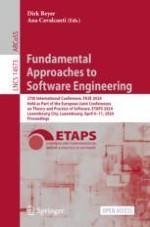Open Access 2024 | Open Access | Buch

Fundamental Approaches to Software Engineering
27th International Conference, FASE 2024, Held as Part of the European Joint Conferences on Theory and Practice of Software, ETAPS 2024, Luxembourg City, Luxembourg, April 6–11, 2024, Proceedings
herausgegeben von: Dirk Beyer, Ana Cavalcanti
Verlag: Springer Nature Switzerland
Buchreihe : Lecture Notes in Computer Science